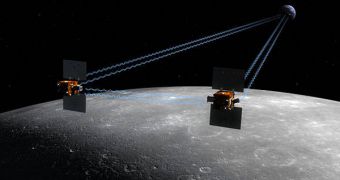In 2011, the world will see the launching of the new Gravity Recovery and Interior Laboratory (GRAIL) observatory, which is destined to become the first gravity-analysis machine on the Moon. Naturally, experts at NASA already know the force with which the satellite acts on incoming or orbiting spacecraft, and even on landers. But, at least in theory, its surface is littered with impact craters from asteroids, micro-meteorites, and other such cosmic events. Buried deep under the crust, these areas of higher density – as in the remains on an asteroid's core – can cause disturbances in the regional gravitational pull, which may be very hazardous to incoming landers.
Once the process is complete, the Moon will have received the most comprehensive and detailed gravitational map of all celestial bodies in the solar system, including our own planet. Just recently, the European Space Agency (ESA) launched the Gravity Field and Steady-State Ocean Circulation Explorer (GOCE) mission, whose purpose is to search for, identify, and catalog minute changes in the Earth's gravitational pull over certain areas. Its sensitive gradiometer is able to pick up tiny fractions of variations, and a smooth flight path is ensured by its rare ion engine.
As far as GRAIL goes, the new twin satellites will most likely use high-quality gravity field mapping of the Moon, in order to determine its inner composition. The goal is to analyze the dense mass concentrations (also known as mascons), which can be made up of just about anything, from meteors to ancient lava or iron-rich sediments lifting up from the satellite's core.
These mascons play a significant role when astronomers calculate the orbits of future lunar orbiters, because they have the ability to drastically influence the probes. The machines then need constant orbit re-adjustments, which ultimately means that their life span considerably shortens, and that they then have to be intentionally crashed on the Moon.
“If you take out the five major mascons on the near side of the moon, orbits are much more stable,” NASA Jet Propulsion Lab (JPL) GRAIL Planetary Scientist Alex Konopliv argued for Space, LiveScience reports. “This mission will give us the most accurate global gravity field to date for any planet, including Earth,” GRAIL mission leader Mariz Zuber, who is also a physicist at the Massachusetts Institute of Technology (MIT), added.
During the experiments, the two satellites will trail each other in lunar orbit, leaving about 124 miles, or 200 kilometers, between them. They will fly in this formation for three months, during which time they will communicate with each other through short-wave microwave channels. Depending on the formations the two probes are moving above, the distance and the relative speed of the two spacecraft will modify accordingly, even if only by a slight value. The fine instruments aboard GRAIL will then interpret the readings and deliver their report to mission controllers back on Earth.

 14 DAY TRIAL //
14 DAY TRIAL //